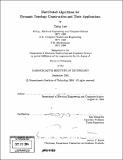| dc.contributor.advisor | Kai-Yeung Siu. | en_US |
| dc.contributor.author | Law, Ching, 1975- | en_US |
| dc.contributor.other | Massachusetts Institute of Technology. Dept. of Electrical Engineering and Computer Science. | en_US |
| dc.date.accessioned | 2005-09-27T17:55:29Z | |
| dc.date.available | 2005-09-27T17:55:29Z | |
| dc.date.copyright | 2004 | en_US |
| dc.date.issued | 2004 | en_US |
| dc.identifier.uri | http://hdl.handle.net/1721.1/28711 | |
| dc.description | Thesis (Ph. D.)--Massachusetts Institute of Technology, Dept. of Electrical Engineering and Computer Science, 2004. | en_US |
| dc.description | Includes bibliographical references (p. 155-162). | en_US |
| dc.description.abstract | (cont.) of piconets is close to optimal, and any device is a member of at most two piconets. | en_US |
| dc.description.abstract | We introduce new distributed algorithms that dynamically construct network topologies. These algorithms not only adapt to dynamic topologies where nodes join and leave, but also actively set up and remove links between the nodes, to achieve certain global graph properties. First, we present a novel distributed algorithm for constructing overlay networks that are composed of d Hamilton cycles. The protocol is decentralized as no globally-known server is required. With high probability, the constructed topologies are expanders with O(logd n) diameters and ... second largest eigenvalues. Our protocol exploits the properties of random walks on expanders. A new node can join the network in O(logd n) time with O(dlogd n) messages. A node can leave in O(1) time with O(d) messages. Second, we investigate a layered construction of the random expander networks that can implement a distributed hash table. Layered expanders can achieve degree-optimal routing at O(log n/log log n) time, where each node has O(log n) neighbors. We also analyze a self-balancing scheme for the layered networks. Third, we study the resource discovery problem, in which a network of machines discover one another by making network connections. We present two randomized algorithms to solve the resource discovery problem in O(log n) time. Fourth, we apply the insight gained from the resource discovery algorithms on general networks to ad hoc wireless networks. A Bluetooth ad hoc network can be formed by interconnecting piconets into scatternets. We present and analyze a new randomized distributed protocol for Bluetooth scatternet formation. We prove that our protocol achieves O(log n) time complexity and O(n) message complexity. In the scatternets formed by our protocol, the number | en_US |
| dc.description.statementofresponsibility | by Ching Law. | en_US |
| dc.format.extent | 162 p. | en_US |
| dc.format.extent | 6066836 bytes | |
| dc.format.extent | 6087619 bytes | |
| dc.format.mimetype | application/pdf | |
| dc.format.mimetype | application/pdf | |
| dc.language.iso | en_US | |
| dc.publisher | Massachusetts Institute of Technology | en_US |
| dc.rights | M.I.T. theses are protected by copyright. They may be viewed from this source for any purpose, but reproduction or distribution in any format is prohibited without written permission. See provided URL for inquiries about permission. | en_US |
| dc.rights.uri | http://dspace.mit.edu/handle/1721.1/7582 | |
| dc.subject | Electrical Engineering and Computer Science. | en_US |
| dc.title | Distributed algorithms for dynamic topology construction and their applications | en_US |
| dc.type | Thesis | en_US |
| dc.description.degree | Ph.D. | en_US |
| dc.contributor.department | Massachusetts Institute of Technology. Department of Electrical Engineering and Computer Science | |
| dc.identifier.oclc | 59552556 | en_US |
